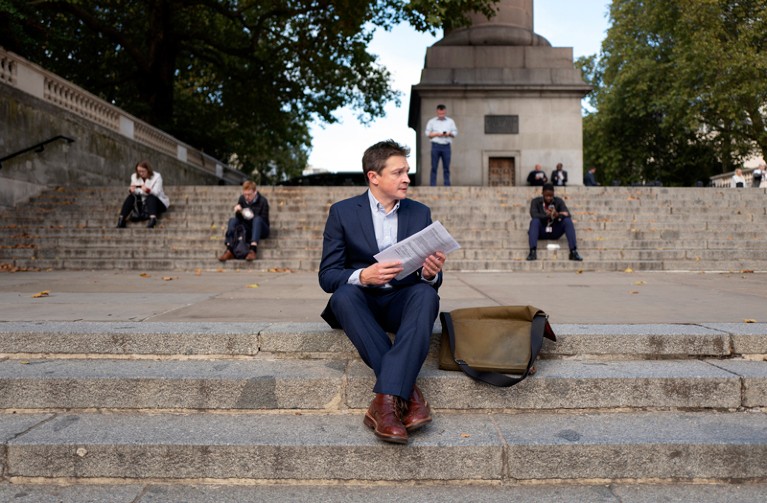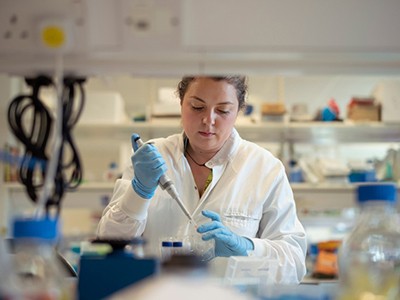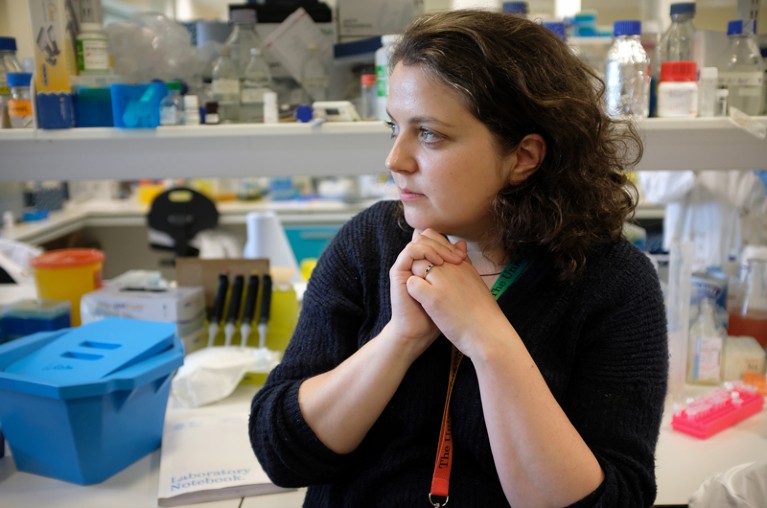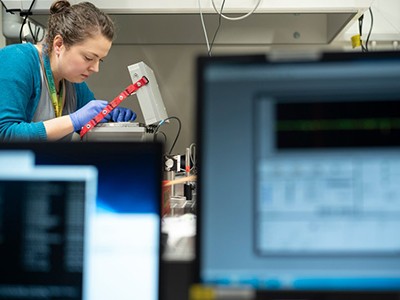
Molecular biologist Daniel Bose, pictured shortly before a grant interview at the Royal Society in London.Credit: Chris Maddaloni for Nature
In 2018, a team of Nature reporters and editors began documenting, in real time, the lives and experiences of two scientists at the University of Sheffield, UK. Alison Twelvetrees, a neuroscientist, and molecular biologist Daniel Bose are on a path to establishing their own research laboratories. They are also a married couple, and their stories — the highs and lows, the triumphs and tribulations — are told in a three-part Feature (and can be heard in a four-part Nature Podcast series).
Starting up in science: two biologists struggle to launch their labs
The intention, with Ali and Dan’s agreement, was to present their lives in science over a year or more. Documenting such a process is not very common in science reporting, where the emphasis is more often on describing results. Our aim was to chronicle the journey involved in becoming a principal investigator (PI). But neither we at Nature, nor Ali and Dan, knew whether they would be able to build up their research groups, or that the story would run for more than three years. In addition to other crises that arose, the pandemic would shut down their experiments.
The United Kingdom’s universities — like those of many countries — are powered by people such as Ali and Dan, who were employed as PIs on fixed-term contracts. In the United Kingdom, some 74,000 academic staff — out of a total of 223,000 — are on such contracts. In the smaller group of staff that do just research, 35,000 out of 50,000 are on fixed-term contracts, according to data from the UK Higher Education Statistics Agency. For the aspiring academic researcher, such a precarious existence is, sadly, a rite of passage.
As if that wasn’t hard enough, applying for a PI position — leading, eventually, to a professorship — is not like applying for a permanent job in many other professions. Researchers wanting to become PIs in universities are required to show evidence of a multiplicity of skills. They must be leaders and managers; entrepreneurs; mentors and teachers; accountants and administrators. And all the while, they must be doing world-leading research and building their publication list. Moreover, not all PI posts are permanent positions. In some cases, candidates must compete with their peers to secure income from external grants to pay their salary.

Neuroscientist Alison Twelvetrees, pictured in her lab at the University of Sheffield.Credit: Chris Maddaloni for Nature
Cycle of precariousness
Ali and Dan’s attempts to win funding provide some of the most revealing aspects of the narrative — for example, having to face questions from up to 20 interviewers for a fellowship worth more than £1 million (US$1.4 million). The researchers had a one-in-five chance of success. If they were successful, their funding would support new research talent in the form of PhDs and postdocs. But, as Ali and Dan’s story indicates, these newer entrants would also be employed on temporary contracts — thus perpetuating the cycle of precariousness in future generations of researchers.
Starting up in science: an agonizing search for cash confronts two labs
The employers of doctors, teachers, architects and engineers do not expect candidates to raise funding to pay their own salaries. Scientists working at universities should not be expected to do that either.
In the United Kingdom, a previous generation of research planners anticipated a situation in which researchers might one day find themselves struggling to pay the rent. A funding principle called the dual support system followed. Its architects established two sources of public funding: one funding pot to pay salaries for staff, and a second for grants and fellowships. It meant that researchers had access to a secure income stream to support their families while applying for grants. Today, that principle is under strain. Ali and Dan’s story emphasizes why something closer to the original plan, which provides greater job security, is needed.
But Dan and Ali’s story isn’t just one of funding. It is also a chronicle of the process of science. Media reporting of science typically covers major findings or policy decisions. But, as researchers know only too well, such outcomes are the final steps in a much longer and more-complex process that typically doesn’t make it into news stories: the joy of receiving a new microscope, or seeing a student’s experiment succeed; the stress of explaining complex science to a lecture theatre packed with students; or the disappointment of getting a funding rejection. These don’t always get covered, and that can create an unbalanced view of what science is.
We’re grateful to Ali and Dan for allowing Nature a glimpse into their lives, to witness the day-to-day struggles, the anxieties, the crises and the victories, large and small. None of us expected this project to last three years. In publishing Ali and Dan’s experiences, we hope to redress some of the imbalance, and to provide a key missing piece of the picture of what it means to be an academic scientist today.

 Starting up in science: two biologists struggle to launch their labs
Starting up in science: two biologists struggle to launch their labs
 Starting up in science: an agonizing search for cash confronts two labs
Starting up in science: an agonizing search for cash confronts two labs
 Starting up in science: two labs face the pandemic and another shock
Starting up in science: two labs face the pandemic and another shock
 New UK science minister takes on ambitious research agenda
New UK science minister takes on ambitious research agenda
 Responsible research assessment faces the acid test
Responsible research assessment faces the acid test
 UK academics seethe over universities’ cost-cutting moves
UK academics seethe over universities’ cost-cutting moves
 Three questions to address rigour and reproducibility concerns in your grant proposal
Three questions to address rigour and reproducibility concerns in your grant proposal








